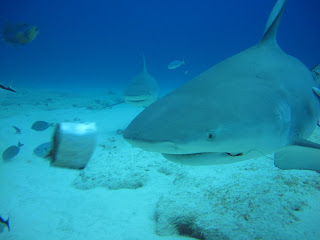The
bull shark’s (Carcharhinus leucas) cause
in Playa del Carmen is a very important aspect for the well being of the reefs.
Phantom Divers collaborates with a non-profit organization named Saving Our
Sharks. Our common objective is to protect the sharks which are an important
indicator of the health of coral reefs.
In
order to determine the best future for the sharks in the Mayan Riviera, Saving Our
Sharks has based its plan of action on scientific research, public outreach,
government legislation to establish Marine Protected Areas (MPA’s) and shark
sanctuaries. Another major objective is
to integrate all of the key stakeholder’s beliefs including fishing collectives
and dive tourism operators.
The
main goal of the research project is to collect scientific data in order to
create an evidence based conservation strategy that will efficiently protect
the sharks.
Saving
Our Sharks is taking the first steps towards recording and analyzing data in
order to gain specific knowledge of bull sharks. In the Riviera Maya there has not been any previous research regarding shark
behavior. Therefore these first steps are key to address the lack of knowledge
around shark behavior. Information such as migration patterns, general
behavior, breeding and pupping sites will allow SOS to determine specific areas
to protect them.
So, one of the first things to ask is why so much research? And what is the purpose and use of it?
These
questions were answered by the team of Saving Our Sharks.
First,
all the data collected from the studies done in the Riviera Maya is being used
to identify the size and principal activities of the shark population. Other extremely important data we are
collecting includes: the division by sex, movements in relation to feeding
patterns and in relation to each other.
This
type of information helps to understand behavioral differences between male and
female sharks. It also provides knowledge about migration, life span, mortality
rates and reproductive cycles.
This
is important to help us to identify: the
times and seasons when of vulnerability as well as the areas for mating and reproduction.
The goal is to use the data to create a network of protected areas for sharks
to be safe and able to sustainably reproduce.
All
the data is being collected and analyzed by a team of dedicated scientists, using
the latest technology and standards.
These include satellite tracking on the Argos system and a
network of acoustic telemetry receivers through out the Caribbean Ocean in QuintanaRoo, Mexico.
Next at the Phantom Divers blog, we will continue to explain the procedures done for the purpose of studying and protecting the sharks.
Join the fight, and be part of the solution, let's help our reefs that we admire so much!





No comments:
Post a Comment